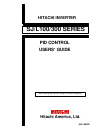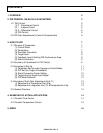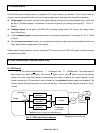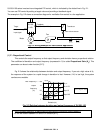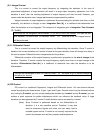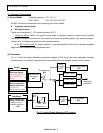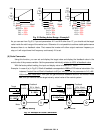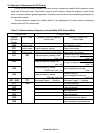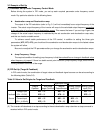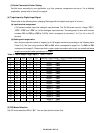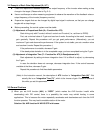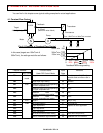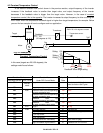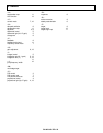
SJ100/L100 / PID / 13
3-4 Example of Each Gain Adjustment (K
p
& T
i
)
l Check the response of feedback signal or the output frequency of the inverter when making a step
change in the target. (Please refer to Fig. 2-4)
l Use an oscilloscope or other measuring equipment to observe the waveform of the feedback value or
output frequency of the inverter (frequency monitor).
l Prepare two targets that can be changed by digital input signal in advance, so that you can change
targets with a step change.
l Before proceeding, the control system must be stable.
(1) Adjustment of Proportional Gain (K
p
: Function No. A72)
Start driving only with P-control, without I-control and D-control (i.e., set them to ZERO).
First, set a minimal value of P-gain and see how it works. According to the result, increase P-
gain gradually. Repeat this procedure until you get good performance. (Alternatively, you set
maximum P-gain and observe the performance. If the system is not stable, you set a medium value
and see how it works. Repeat this procedure...)
If the performance is unstable, decrease P-gain.
If the steady state deviation is in the acceptable range, you have completed tuning the P-gain.
(2) Adjustment of Integration Time (T
i
: Function No. A73) & Readjustment of K
p
Start adjustment by setting minimum integration time. If it is difficult to adjust, try decreasing
the P-gain.
In case the deviation does not converge, decrease integration time. If the control becomes
unstable at that time, decrease P-gain.
Repeat this procedure to find the suitable parameters.
(Note) In the instruction manual, the description of A73 function is “Integration Gain (Ki)”. But
actually this is an “Integration Time (Ti)”, which is the inverse of gain. Please be aware of
this while you set this parameter.
3-5 General Cautions
(1) When you set AVR function (A81) to “DOFF” (which makes the AVR function invalid while
decelerating) with PID control, there is a possibility the motor may exhibit hunting in some
applications. This is because the motor repeatedly accelerates and decelerates each time the AVR
function operates. This may lead to unstable rotation of the motor.
Solution: Set AVR function ALWAYS OFF in this case.



